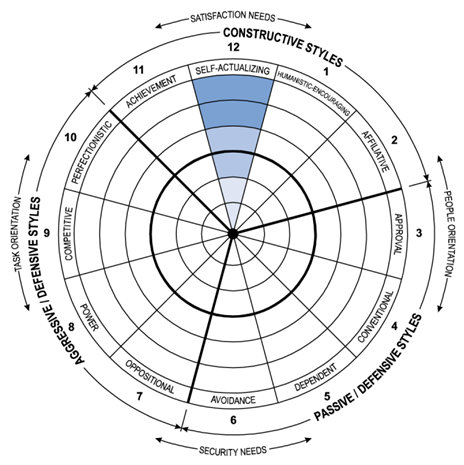In a previous article, we introduced the Human Synergistics Circumplex™, a proven framework to measure, report, discuss and better understand individual and collective human behaviour, and their impact upon business and organisational performance (refer: Catching Smoke: A Proven Framework for Addressing Culture and Leadership).
This latest article focuses on another of the Constructive styles –Self-Actualising: what it’s all about, how it can improve your personal effectiveness and/or the performance of your business/organisation and how to, at a personal and/or workplace culture level, enhance the focus on Self-Actualising thinking and behaviours.

So Just What is Self-Actualising?
Whether we’re looking at it from an individual leadership or broader workplace culture perspective, driving characteristics of the Self-Actualising style include the desire to explore new opportunities, be innovative, creative, and focus on growth and ongoing development.
Leaders who are personally high in the Self-Actualising style will tend to, for example:
- seek and embrace opportunities for personal growth and development
- be “out-of-the-box” thinkers, though balance this with a healthy dose of realism
- focus on enjoying their work
- be independent thinkers, and
- emphasise quality over quantity.
Workplace cultures can themselves become Self-Actualising in nature, in which participants feel expected or implicitly required to, for example:
- always look to improve the quality of what they do
- consider new ways of doing things, be spontaneous, flexible and embrace change where it’s focused on improving the business and/or the range of products and services offered
- communicate their ideas freely, and be open to others, and
- be focused on their personal growth and development.
So Why Should I Focus on Self-Actualising?
It should be fairly apparent from the examples above that developing/promoting Self-Actualising thinking and behaviours at both personal and workplace culture levels is worthwhile.
Indeed, research over several decades by Human-Synergistics has consistently shown that workplaces high in the Self-Actualising style (and the other Constructive styles – Achievement, Humanistic-Encouraging and Affiliative) are significantly more effective than workplaces with predominantly defensive cultures.
Indeed, primarily Constructive workplaces:
- are 32% more able to effectively respond to changes in the external environment
- achieve 32% higher quality performance
- demonstrate 28% more effective teamwork
- have a 25% greater commitment to producing a quality result
- include individuals that are 32% more motivated, 26% more satisfied and 25% more likely to stay with the organisation.
Individual leaders high in the Self-Actualising style are personally more creative, innovative and satisfied. They tend to be more popular with their teams, produce higher quality work and are predominantly driven to achieve collective rather than individual success.
Workplace cultures high in Self-Actualising are regarded as great places to work so attract and retain talented staff, produce quality, innovative products and services that give them a competitive advantage, and adapt particularly well to changes in the external environment.
Developing/Promoting Self-Actualising Thinking and Behaviour
If you think you could benefit by developing more Self-Actualising thinking and behaviour at an individual leadership level, try for example:
- Try new things (eg. rotate meeting chair, give someone else ownership of a key project, get to work a different way!)
- Focus on the positive, be enthusiastic and observe the impact on your team
- Be more open about yourself
- Complete challenging, unappealing tasks sooner than later
- Make a commitment to stretch yourself, to learn something new – personal or professional.
To encourage Self-Actualising thinking and behaviours at a collective/workplace level, try for example:
- Directly challenge your team to come up with new ways of doing things
- Be sure to welcome and value new ideas when they are presented (even when it’s not a great idea, be sure to appreciate the thinking behind it)
- Demonstrate through your direct communications and behaviours that you value quality
- Identify and pursue opportunities to inject a bit of fun into the workplace
- Utilise brainstorming and other techniques in team meetings, to stimulate new and different ways of thinking.
We’ll continue in future articles to look at the what, why and how of other workplace culture and personal leadership styles. In the meantime, be sure to call if you’d like to explore the range of culture and leadership programs we have available to help transform your people, your team and your business/organisation.
If you’ve missed our previous articles on the other styles, be sure to check out our blog – look for the “Focus on Culture and Leadership” series of articles.

